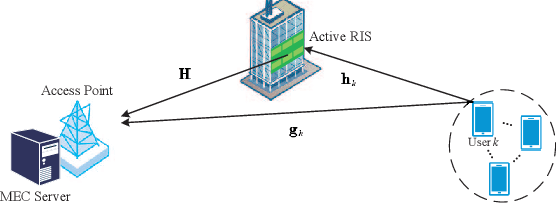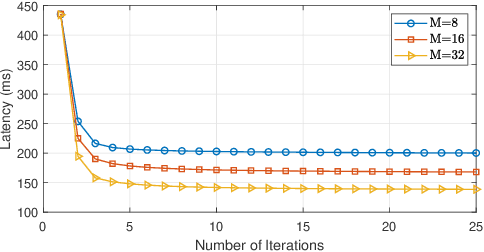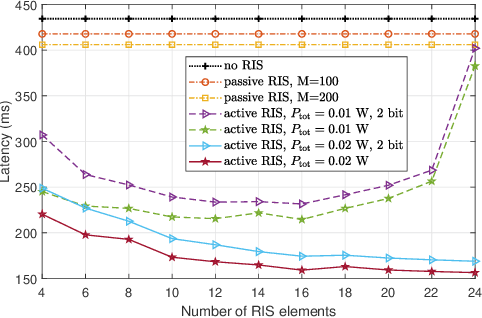Ruisong Weng
Channel Estimation for RIS-Aided MU-MIMO mmWave Systems with Practical Hybrid Architecture
Feb 08, 2025



Abstract:This paper proposes a correlation-based three-stage channel estimation strategy with low pilot overhead for reconfigurable intelligent surface (RIS)-aided millimeter wave (mmWave) multi-user (MU) MIMO systems, in which both users and base station (BS) are equipped with a hybrid RF architecture. In Stage I, all users jointly transmit pilots and recover the uncompressed received signals to estimate the angle of arrival (AoA) at the BS using the discrete Fourier transform (DFT). Based on the observation that the overall cascaded MIMO channel can be decomposed into multiple sub-channels, the cascaded channel for a typical user is estimated in Stage II. Specifically, using the invariance of angles and the linear correlation of gains related to different cascaded subchannels, we use compressive sensing (CS), least squares (LS), and a one-dimensional search to estimate the Angles of Departure (AoDs), based on which the overall cascaded channel is obtained. In Stage III, the remaining users independently transmit pilots to estimate their individual cascaded channel with the same approach as in Stage II, which exploits the equivalent common RIS-BS channel obtained in Stage II to reduce the pilot overhead. In addition, the hybrid combining matrix and the RIS phase shift matrix are designed to reduce the noise power, thereby further improving the estimation performance. Simulation results demonstrate that the proposed algorithm can achieve high estimation accuracy especially when the number of antennas at the users is small, and reduce pilot overhead by more than five times compared with the existing benchmark approach.
Reconfigurable Intelligent Surface-Aided Dual-Function Radar and Communication Systems With MU-MIMO Communication
Feb 08, 2024



Abstract:In this paper, we investigate an reconfigurable intelligent surface (RIS)-aided integrated sensing and communication (ISAC) system. Our objective is to maximize the achievable sum rate of the multi-antenna communication users through the joint active and passive beamforming. {Specifically}, the weighted minimum mean-square error (WMMSE) method is { first} used to reformulate the original problem into an equivalent one. Then, we utilize an alternating optimization (AO) { algorithm} to decouple the optimization variables and decompose this challenging problem into two subproblems. Given reflecting coefficients, a penalty-based algorithm is utilized to deal with the non-convex radar signal-to-noise ratio (SNR) constraints. For the given beamforming matrix of the BS, we apply majorization-minimization (MM) to transform the problem into a quadratic constraint quadratic programming (QCQP) problem, which is ultimately solved using a semidefinite relaxation (SDR)-based algorithm. Simulation results illustrate the advantage of deploying RIS in the considered multi-user MIMO (MU-MIMO) ISAC systems.
Joint Beamforming Design for Double Active RIS-assisted Radar-Communication Coexistence Systems
Feb 07, 2024



Abstract:Integrated sensing and communication (ISAC) technology has been considered as one of the key candidate technologies in the next-generation wireless communication systems. However, when radar and communication equipment coexist in the same system, i.e. radar-communication coexistence (RCC), the interference from communication systems to radar can be large and cannot be ignored. Recently, reconfigurable intelligent surface (RIS) has been introduced into RCC systems to reduce the interference. However, the "multiplicative fading" effect introduced by passive RIS limits its performance. To tackle this issue, we consider a double active RIS-assisted RCC system, which focuses on the design of the radar's beamforming vector and the active RISs' reflecting coefficient matrices, to maximize the achievable data rate of the communication system. The considered system needs to meet the radar detection constraint and the power budgets at the radar and the RISs. Since the problem is non-convex, we propose an algorithm based on the penalty dual decomposition (PDD) framework. Specifically, we initially introduce auxiliary variables to reformulate the coupled variables into equation constraints and incorporate these constraints into the objective function through the PDD framework. Then, we decouple the equivalent problem into several subproblems by invoking the block coordinate descent (BCD) method. Furthermore, we employ the Lagrange dual method to alternately optimize these subproblems. Simulation results verify the effectiveness of the proposed algorithm. Furthermore, the results also show that under the same power budget, deploying double active RISs in RCC systems can achieve higher data rate than those with single active RIS and double passive RISs.
Secure Wireless Communication in Active RIS-Assisted DFRC System
Feb 03, 2024



Abstract:This work considers a dual-functional radar and communication (DFRC) system with an active reconfigurable intelligent surface (RIS) and a potential eavesdropper. Our purpose is to maximize the secrecy rate (SR) of the system by jointly designing the beamforming matrix at the DFRC base station (BS) and the reflecting coefficients at the active RIS, subject to the signal-to-interference-plus-noise-ratio (SINR) constraint of the radar echo and the power consumption constraints at the DFRC-BS and active RIS. An alternating optimization (AO) algorithm based on semi-definite relaxation (SDR) and majorizationminimization (MM) is applied to solve the SR-maximization problem by alternately optimizing the beamforming matrix and the reflecting coefficients. Specifically, we first apply the SDR and successive convex approximation (SCA) methods to transform the two subproblems into more tractable forms, then the MM method is applied to derive a concave surrogate function and iteratively solve the subproblems. Finally, simulation results indicate that the active RIS can better confront the impact of "multiplicative fading" and outperforms traditional passive RIS in terms of both secure data rate and radar sensing performance.
Active Reconfigurable Intelligent Surface for Mobile Edge Computing
Sep 07, 2022



Abstract:This paper investigates an active reconfigurable intelligent surface (RIS)-aided mobile edge computing (MEC) system. Compared with passive RIS, the active RIS is equipped with active reflective amplifier, which can effectively circumvent the "double path loss" attenuation. We propose a joint computing and communication design to minimize the maximum computational latency (MCL), subject to both the phase shift constraints and the edge computing capability constraints. Specifically, the original problem is decoupled into four subproblems, and then the block coordinate descent (BCD) method and the successive convex approximation (SCA) method are applied to alternately optimize the subproblems. The simulation results show that with the same power budget, the performance gain achieved by the active RIS is much larger than that by the passive RIS.
Robust Transmission Design for RIS-assisted Secure Multiuser Communication Systems in the Presence of Hardware Impairments
Feb 24, 2022



Abstract:This paper investigates reconfigurable intelligent surface (RIS)-assisted secure multiuser communication systems subject to hardware impairments (HIs). We jointly optimize the beamforming vectors at the base station (BS) and the phase shifts of the reflecting elements at the RIS so as to maximize the weighted minimum secrecy rate (WMSR), subject to both transmission power constraints at the BS and unit-modulus constraints at the RIS. To address the formulated optimization problem, we first decouple it into two tractable subproblems and then use the block coordinate descent (BCD) method to alternately optimize the subproblems. Two different methods are proposed to solve the two obtained subproblems. The first method transforms each subproblem into a second order cone programming (SOCP) problem, which can be directly solved using CVX. The second method leverages the Minorization- Maximization (MM) algorithm. Specifically, we first derive a concave approximation function, which is a lower bound of the original objective function, and then the two subproblems are transformed into two simple surrogate problems with closedform solutions. Simulation results verify the performance gains of the proposed robust transmission method over existing nonrobust designs. In addition, the MM algorithm is shown to have much lower complexity than the SOCP-based algorithm.
 Add to Chrome
Add to Chrome Add to Firefox
Add to Firefox Add to Edge
Add to Edge